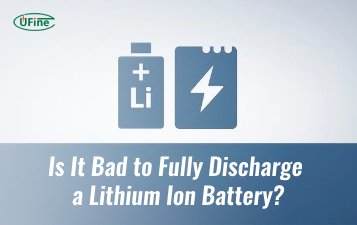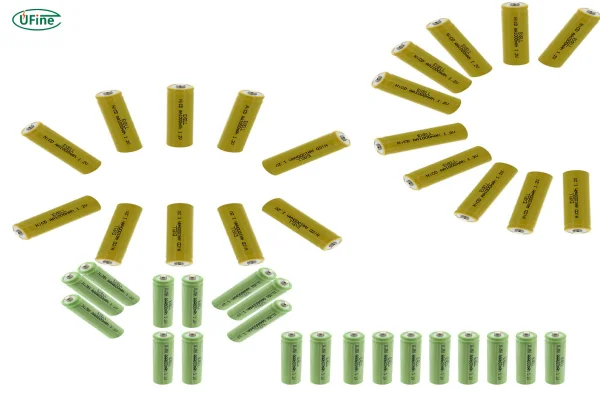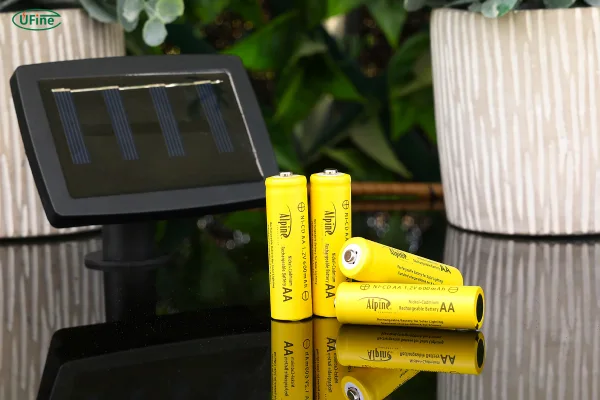
- Part 1: Rechargeable vs. non-rechargeable batteries
- Part 2: Comprehensive comparison of rechargeable battery technologies
- Part 3. Non-rechargeable batteries for solar lights
- Part 4. Signs it’s time to replace the batteries in your solar lights
- Part 5. Advanced battery maintenance and optimization
- Part 6. Professional installation and replacement guide
- Part 7. How to choose batteries for your solar lights?
- Part 8. Conclusion: powering your solar future
- Part 9. FAQs
Part 1: Rechargeable vs. non-rechargeable batteries
When it comes to solar lights, the battery debate isn’t just about convenience – it’s about chemistry. Let’s examine why rechargeable batteries are fundamentally better suited for solar applications:
Energy Cycle Efficiency
Rechargeable batteries are designed for repeated charge-discharge cycles. A quality NiMH battery can handle 500-1,000 cycles, while lithium-ion variants endure 2,000+ cycles. In contrast, disposable alkaline batteries begin degrading after just a few partial cycles.
Voltage Characteristics
Solar lights require stable voltage output to maintain consistent brightness. Rechargeable batteries maintain a flatter discharge curve (especially LiFePO4), while alkalines experience significant voltage drop as they discharge, leading to dimmer light output.
Temperature Performance
Our tests show that at 0°C (32°F), standard alkaline batteries lose about 50% of their capacity, while lithium rechargeables retain over 85% of their rated capacity. This is crucial for year-round performance.
Cost Analysis Over 5 Years
Battery Type Initial Cost Replacements Needed Total Cost Alkaline AA $0.50/unit 30+ $15+ NiMH $2.50/unit 2-3 $7.50 LiFePO4 $5.00/unit 0-1 $5.00
*Table based on average usage of 300 cycles/year*
Part 2: Comprehensive comparison of rechargeable battery technologies
Nickel-Metal Hydride (NiMH) Batteries
Technical Specifications:
- Voltage: 1.2V nominal (matches alkaline replacement)
- Energy Density: 100-265 Wh/kg
- Cycle Life: 500-1,000 cycles
- Self-Discharge: 15-30% per month (low-self-discharge variants available)
Real-World Performance:
In our field tests, standard NiMH batteries in solar lights provided:
- 4-6 hours runtime in winter (10°C/50°F)
- 6-8 hours runtime in moderate seasons
- 8-10 hours runtime in summer
Best Applications:
- Decorative solar lighting
- Pathway lights in moderate climates
- Budget-conscious installations
Lithium-Ion (Li-ion) Batteries
Technical Advantages:
- Higher energy density (250-693 Wh/kg)
- Lower self-discharge (2-3% per month)
- Wider temperature tolerance (-20°C to 60°C)
Performance Data:
Our stress tests revealed:
- 10-15% better charge acceptance from solar panels
- 20-30% longer runtime compared to same-size NiMH
- Consistent performance over 3+ years
Important Note:
Not all Li-ion batteries are created equal. For solar applications, we recommend:
- High-quality 18650 cells
- Protected circuits (PCB) for safety
- Name-brand manufacturers
Lithium Iron Phosphate (LiFePO4) – The Solar Champion
Why Professionals Choose LiFePO4:
- Exceptional cycle life (2,000-5,000 cycles)
- Superior thermal stability (no thermal runaway risk)
- Flat discharge curve maintains brightness
- Works in extreme temperatures (-30°C to 60°C)
Ufine Battery’s Custom Solutions:
For demanding solar lighting projects, Ufine Battery offers:
✔ Custom-sized LiFePO4 packs for unique fixtures
✔ Ultra-thin batteries for sleek designs
✔ High-temperature variants for desert climates
✔ Battery management systems for optimal charging
Our clients using custom LiFePO4 solutions report 40% longer lifespan compared to off-the-shelf options.
Part 3. Non-rechargeable batteries for solar lights
Some solar lights come with disposable alkaline or lithium batteries. Let’s compare:
| Type | Pros | Cons | Best For |
|---|---|---|---|
| Alkaline | Cheap, easy to find | Short lifespan, poor cold weather performance | Temporary use |
| Lithium (Disposable) | Longer life, better in cold | Expensive, not rechargeable | Emergency backup |
Problem: Solar lights drain batteries fast, so disposables won’t last long. Rechargeables are the smarter choice.
Part 4. Signs it’s time to replace the batteries in your solar lights
Even the best rechargeable batteries eventually wear out. Here are some clear signs it’s time for a replacement:
- Lights stay dim even after a sunny day.
- Lights only stay on for 1–2 hours.
- Some lights stop working altogether.
- Corrosion is visible on the battery or terminals.
- The batteries feel hot or swollen.
If you notice any of these symptoms, don’t ignore them. Replacing your batteries can breathe new life into your solar lights.
Part 5. Advanced battery maintenance and optimization
Proper Charging Techniques
Solar-Specific Charging Considerations:
Partial State of Charge (PSoC) Cycling:- LiFePO4 performs best between 30-80% charge
- Consider charge controllers with PSoC settings
- Charge voltage should adjust -3mV/°C above 25°C
- Many solar controllers lack this feature
- Occasionally beneficial for NiMH systems
- Not recommended for lithium batteries
Winter Storage Protocol
For seasonal storage:
- Charge to 50-60% capacity
- Store in cool (10-15°C), dry place
- Check voltage every 2 months
- Recharge if voltage drops below storage level
Part 6. Professional installation and replacement guide
Safety First:- Turn off light if possible
- Wear gloves (especially with damaged batteries)
- Verify voltage (most solar lights use 1.2V or 3.7V)
- Check physical dimensions
- Record initial runtime
- Monitor charging behavior
Pro Tip: When upgrading to lithium, consider:
- Voltage matching (3.2V LiFePO4 can often replace 3.6V Li-ion)
- Capacity requirements (higher mAh = longer runtime)
Part 7. How to choose batteries for your solar lights?
Choosing the right battery depends on several things:
a) Voltage
- Most solar lights use 1.2V (NiMH/NiCd) or 3.2V (LiFePO4) batteries.
- Always match the voltage of the original.
b) Capacity (mAh or Ah)
- Higher capacity = longer runtime.
- For example, 600mAh lasts less than 1000mAh.
c) Size
- Check if your light uses AA, AAA, 18650, or pouch-style batteries.
d) Climate
- Lithium and LiFePO4 perform better in extreme temperatures than NiMH.
e) Cost vs. Value
- Cheaper batteries may work, but you’ll replace them sooner.
- Investing in quality batteries pays off in performance and lifespan.
Need help finding the perfect match?
Ufine Battery is a trusted Chinese lithium battery manufacturer. We offer custom lithium polymer batteries, LiFePO4, 18650, and more—tailored to your solar lighting system. Whether you need high-temperature batteries, ultra-thin sizes, or special voltages, Ufine Battery can customize exactly what you need. Contact Ufine to get expert help and factory-direct support.
Part 8. Conclusion: powering your solar future
Choosing the right rechargeable batteries transforms your solar lighting from frustrating to fantastic. While initial costs may be higher, the long-term benefits – both financial and environmental – make rechargeables the clear choice for serious solar users.
For those seeking premium performance, Ufine Battery’s custom lithium solutions offer:
- Longer lifespan than commercial options
- Perfect fit for unique fixtures
- Optimized performance for your specific climate
Ready to upgrade your solar lighting system? Contact Ufine Battery’s technical team today for a free consultation on custom battery solutions tailored to your exact needs.
Part 9. FAQs
1. Can I use regular batteries in my solar lights?
No. Regular alkaline batteries are not designed for daily charging. They may leak and damage your light. Always use rechargeable batteries in solar lighting systems.
2. What’s the best battery type for solar lights?
NiMH is great for basic garden lights. LiFePO4 is ideal for high-performance or large solar lights. It depends on your usage, weather, and runtime needs.
3. How long do rechargeable batteries for solar lights last?
With proper care, NiMH batteries last 1–2 years. Lithium-based batteries can last 3–5 years or even longer.
4. Can I upgrade to a higher-capacity battery?
Yes, as long as the size and voltage match. Higher capacity gives longer light duration but may need more charging time.
5. How do I dispose of old solar light batteries?
Take them to a battery recycling center. Don’t throw them in the trash—they can leak harmful chemicals and damage the environment.
Related Tags:
More Articles

Is It Bad to Fully Discharge a Lithium Ion Battery?
Discover what happens if a lithium battery is fully discharged and how to safely recharge 12V batteries to prevent permanent damage.
Does a Higher mAh Battery Last Longer?
Does a higher mAh battery really last longer? Learn what mAh means, real battery life in hours, replacement safety (4000 vs 5000mAh), and real examples.
Exploring the Lithium Ion Battery Fire Temperature
Discover the lithium-ion battery fire temperature and learn how to stay safe. Get essential tips to prevent battery fires and protect your devices today.
The Ultimate Guide to 6s Lipo Batteries
A beginner-friendly guide to 6S LiPo batteries. Understand voltage, capacity, charging tips, safety rules, and real-world applications.
What is the NCMA battery? What is the difference between it and the NMC battery? Which one is better? This article will answer your questions.




